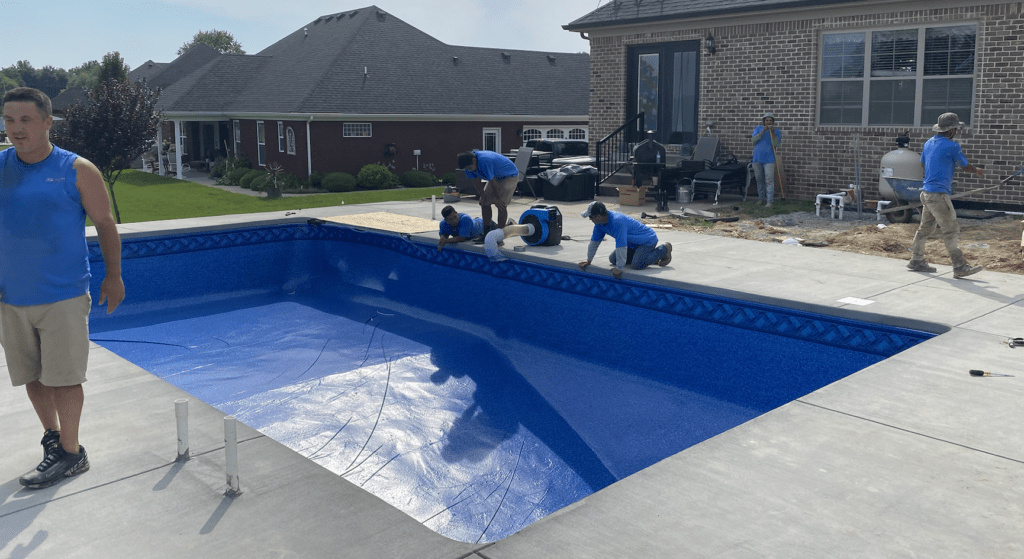As a pool installation company with years of experience in Louisville, we’ve seen countless examples of other companies installing pools poorly.
Whether you’re a homeowner looking to install an inground pool for your home, or you’re a contractor looking to get into the space, mistakes are common if you’re new to the industry.
Installing a swimming pool is exciting, but it’s also complex and requires careful planning.
To ensure that the pool installation process goes smoothly and doesn’t turn into a costly endeavor, it’s important to be aware of common mistakes that homeowners and contractors make.
Here’s a guide to help you avoid these pitfalls and ensure a successful installation.
1- Ignoring Local Regulations
One of the first steps in pool installation should be to understand local building codes and regulations.
Each area has its own set of rules regarding pool construction, including zoning laws, building permits, and safety requirements.
Failing to comply with these regulations can lead to fines, forced removal of the pool, or problems when trying to sell your home.

For instance, in Louisville, KY, pool owners are required to obtain a building permit before installing a pool, which involves submitting detailed plans to the local building department for approval.
This ensures that the pool meets safety standards, such as proper fencing and self-closing gates to prevent accidental drownings.
Louisville’s codes also mandate specific barrier and fencing requirements designed to enhance safety around pool areas.
These regulations specify the height and type of barriers that must be installed, as well as the placement of latches and locks on gates. Compliance with these rules is checked during inspections, which are part of the permitting process. Ignoring or being unaware of these requirements can not only delay the completion of your pool project due to failed inspections but also pose serious safety risks.
2– Choosing the Wrong Location
Choosing the optimal location for a pool is more than just about aesthetics; it directly impacts the usability and maintenance of the pool.
For instance, placing a pool too close to trees can lead to excessive leaf debris and potential damage from roots growing into the plumbing system.
A real-life example of this occurred in a residential area near Louisville, where a homeowner had to spend thousands on repairs because roots from a nearby old oak tree invaded the pool’s filtration system.
Also – it’s important to be mindful of sunlight exposure.
Pools placed in overly shaded areas can remain too cold, reducing their usability during cooler months.
Proper drainage is crucial when selecting a pool location.
A pool installed in a low-lying area of the yard might collect runoff during rainstorms, leading to murky water and potential contamination.
When a homeowner’s newly installed pool suffered recurrent algae problems due to runoff from a nearby hill flooding the pool with nutrients and pollutants, it’s because the location wasn’t accounted for in the installation.
Choosing the right kind of pool to instal is always a great start before constructing – that way you’re already aware of the pool’s space and dimensions.
Proper grading and positioning away from natural runoff paths are essential to prevent such issues.
3- Compromising on Quality for Cost
Every homeowner wants the best deal for their new pool.
But often, this means skimping on the long-term health of the pool and intentionally leaving out what’s most important for the health and safety of your family.
While it’s tempting to cut costs, opting for cheaper materials and labor can lead to higher expenses in the long run due to maintenance issues and shorter lifespans.
Compromising on quality to save costs upfront can lead to significant expenses down the line. For example, a pool owner in Middletown, KY opted for a less expensive pool liner to cut costs.
Within two years, the liner faded and tore due to the high sun exposure and frequent use, necessitating a costly replacement.
Investing in UV-resistant, high-quality liners would have prevented this premature wear. Similarly, cheaper pumps and filters might not efficiently circulate and clean the pool water, leading to increased chemical costs and more frequent maintenance.
Another real-world example involves a pool installation in Arizona, where the homeowner chose inexpensive, non-slip-resistant tiles for the pool deck to reduce costs.
This decision resulted in multiple slip-related accidents, especially when the tiles were wet.
The homeowner faced not only higher insurance claims but also had to replace the decking entirely with safer materials, doubling the original expenditure.
4- Inadequate Planning for Pool Size and Depth
Homeowners in Kentucky often underestimate the amount of space needed around the pool for decks, landscaping, and safety barriers.
Consider how you plan to use the pool. Is it for laps, recreation, or both? Will children be using the pool?
These factors will influence the size and depth that’s best for your needs.
Inadequate planning for the pool size and depth can lead to significant problems down the line, both functionally and financially.
For instance, a homeowner in Louisville once installed a pool that was too deep for casual use and not long enough for laps, aiming primarily for aesthetic appeal.
This decision ultimately limited the pool’s usability for family activities and exercise, leading to dissatisfaction and underuse. The deeper pool required more water and chemicals to maintain, increasing the ongoing costs significantly.
Proper consideration of the intended use of the pool during the planning phase would have led to a more appropriate and cost-effective design.
5- Overlooking Long-Term Maintenance
Maintaining a pool requires time and money.
Before installing a pool, make sure you are prepared for the ongoing costs associated with chemicals, cleaning, and equipment maintenance.

Installing features that reduce maintenance, like robotic cleaners or saltwater chlorination systems, can be initially more expensive but beneficial in the long run.
Neglecting to consider long-term maintenance can turn a pool into a costly and time-consuming endeavor.
Take, for instance, a homeowner outside Louisville who installed a large, intricate pool without considering the ongoing maintenance it would require.
The complex features, such as a waterfall and extensive landscaping, significantly increased the time and money spent on upkeep.
Calculating these costs beforehand would have allowed for a design that balanced aesthetics with manageability.
Not to mention the costs of replacing pool liners, which happen once a decade or so to maintain that aesthetic appeal.
6- Neglecting Safety Features
Safety should be a top priority in pool installation.
Ensure that your pool has appropriate safety features such as fencing, secure pool covers, and anti-entrapment devices to protect against accidents.

Local codes may dictate specific safety requirements, so it’s important to comply with these.
For example, if your home has young children it’s always a smart idea to install a fence around the pool when it’s open to prevent any tragedies from occurring.
Also – making sure the pool’s chemical balance is taken care of is important for avoiding too much or too little chlorine, which can be damaging to your health.
7- Failing to Consider Future Needs
Think about how your needs might change over time.
For example, a pool that’s perfect for young children might not meet your needs as they grow. Consider features that can be adapted or upgraded.
Think about how the pool design fits with your long-term landscaping or property development plans if you plan on selling the home in the near future.
For instance, a family in Charlestown, IN installed a shallow, small pool when their children were young, focusing on safety and play.
As the kids grew older and became interested in swimming as a sport, the pool’s size and depth no longer supported their needs for lap swimming, necessitating an expensive and disruptive renovation.
Planning for adaptable features or a pool that meets both current and future needs can prevent such scenarios.
8- Not Consulting with a Professional
Even if you are a seasoned DIYer, pool installation is a project that benefits significantly from professional input.
From design to excavation to plumbing, professionals will help avoid costly mistakes and ensure that the pool meets all necessary standards and requirements.

Skipping professional consultation can lead to design and technical errors that are costly to rectify. A homeowner in Prospect, KY decided to undertake a DIY pool installation, relying on generic online guides
Unfortunately, the lack of professional design led to improper circulation patterns and inefficient heating, leading to higher energy costs and uneven heating issues.
Consulting with a professional could have optimized the design for functionality and energy efficiency.If you’re a homeowner in the Louisville area looking to consult professionals before installing a pool, give us a free call at (502) 308-4555.


